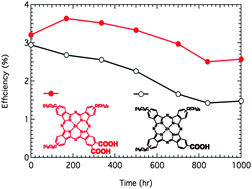We have designed and developed an unsymmetrical zinc phthalocyanine (TT9) sensitizer that consists of three tert-butyl and two carboxylic acid groups that act as “push” and “pull”, respectively. The two carboxylic acid groups graft the sensitizer onto the semiconductor surface resulting in enhanced stability under heat and light compared to the similar unsymmetrical zinc phthalocyanine (TT1) sensitizer that consists of three tert-butyl and only one carboxylic acid groups. The solar cells containing the TT9 and TT1 sensitizers with non-volatile electrolyte were subjected to light soaking conditions at 60 degrees C. Under these conditions, the short circuit current of the TT1 sensitized solar cell after 1000 h decreases to half of its initial value where as the TT9 sensitized solar cell remained the same demonstrating the influence of number of anchoring groups on the stability of zinc phthalocyanine sensitized solar cells.
